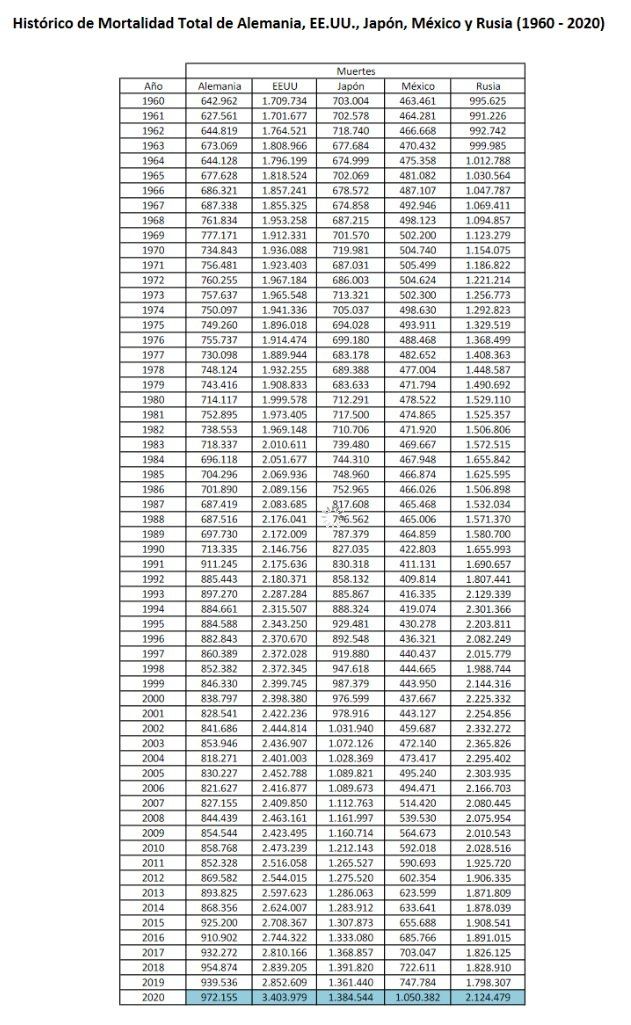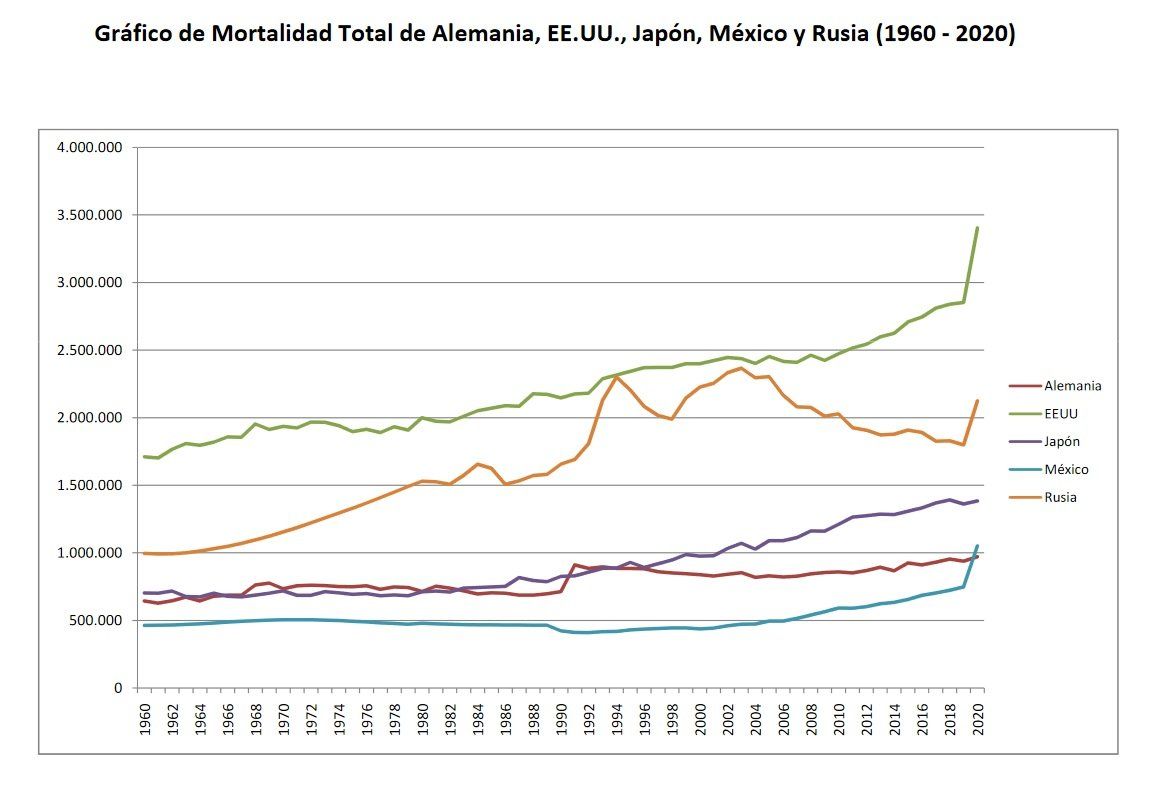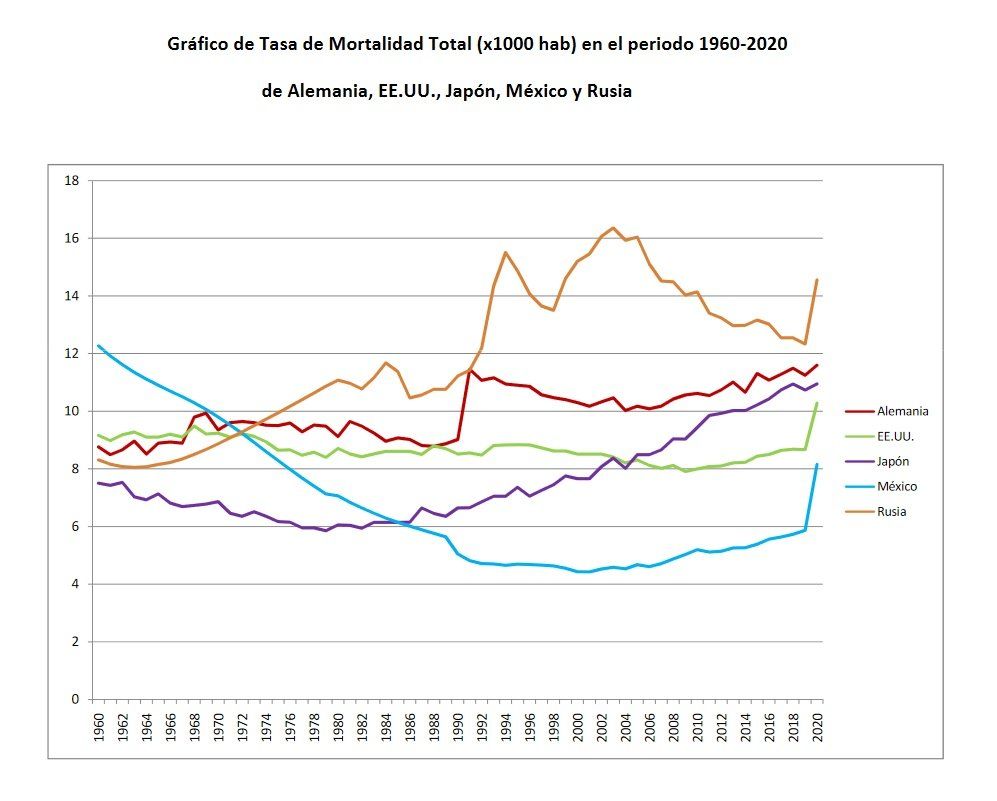Comparative Mortality Analysis by Country Groups -
Long Term Outlook
Group 4: Germany, USA, Japan, Mexico and Russia
With the data from the previous Post in relation to Total Mortality between 1960 and 2020 we make a joint table of Mortality between 1960 and 2020 for Germany, USA, Japan, Mexico and Russia:
In this graph it can already be seen that similar countries in population have had unequal behaviors in the last 60 years. In this graph we can see 3 countries (Germany, USA and Mexico) are at all-time highs for the study period; Germany narrowly, and the US and Mexico easily. On the other hand, there are 2 countries: Japan and Russia are not in this situation: Japan has not yet exceeded its maximum precedent of 2018. Nor has Russia exceeded its maximum precedent of 2003. Be careful, this does not mean that it is good or bad They are simply objective data.
We also find significant the small growth in Total Mortality this past year 2020 of Japan and Germany, compared to the Total Mortalities of 2020 of the USA, Mexico and Russia.
Next, we proceed to calculate the annual Mortality Rates for each country, using the data from the website www.macrotrends.net.
I leave here, for those who are interested, the sources and specific calculations made for each country in relation to the calculation of the annual Total Mortality Rate between 1960 and 2020 in the following links:
- Germany Annual Total Mortality Rate Calculation (pdf)
- USA Annual Total Mortality Rate Calculation (pdf)
- Japan Annual Total Mortality Rate Calculation (pdf)
- Mexico Annual Total Mortality Rate Calculation (pdf)
- Russia Annual Total Mortality Rate Calculation (pdf)
With the data of the annual Total Mortality Rates for each country, the table of Total Mortality Rate (1960 - 2020) will be generated as a whole, as well as their respective graphs with the Total Mortality Rate as a whole for this period.
Comment on the Mortality Rate some interesting points:
- It is common to read that to compare Mortalities between countries it is better to use the Mortality Rate than the Mortality itself because it includes the size of each population and to be able to compare them appropriately. This is true, but it must be borne in mind that including the “population” factor, or more specifically the annual evolution of the annual population of a territory or a country, includes in itself other added concepts such as births as opposed to deaths as well as immigration as opposed to emigration. Elements that would require a more complex treatment and that we are not going to analyze in depth.
For this reason, we want to emphasize that the Total Mortality graphs for the study of Mortality itself seem more reliable for the long term than the Mortality Rate itself, which has these added concepts.
In fact, as you can see in the graphs, the results of Mortality and Mortality Rate are usually very different, since they reflect these other concepts that we have mentioned.
- Another way to see how the Mortality Rate acts, would be understanding that if the rate of growth of mortality is adjustable to the rate of growth of the population of a country, the rate of mortality would be neutral or constant over time. Therefore, the Mortality Rate also measures how the growth of mortality varies in relation to the growth of the population of a country.
- In some way, the study in terms of Mortality Rate also means that Mortality variations are not directly appreciated, and the degree of detail obtained with the Mortality study is hardly reflected in the Mortality Rate itself, as less in the long-term study.
Analysis of the overall graph of the Total Mortality Rate in relation to the Total Mortality Rate:
There will be people who are experts in the field who can get more out of these graphs than we can, but we will try to provide a brief conclusion or common sense reasoning:
Regarding Germany: We see that the Mortality Rate in Germany has been quite lateral or neutral until 1990, in 1991 it went up a notch to become lateral again. This year 2020 the Total Mortality Rate is at all-time highs for the study period. The Mortality graph reflects in this case practically the same as the Mortality Rate, possibly due to the low population growth in Germany in the last 60 years. Despite being in the group of countries with historical highs in Mortality and Mortality Rate, its situation is somewhat contained compared to other countries.
Regarding the US: The US Mortality Rate has been lateral or neutral, until this year 2020, in which it has surpassed its maximum precedents of 1968, reaching all-time highs for the study period. Regarding Total Mortality, we see that its trend has been upward since 1960, and it has been in 2020 when it has rampaged upwards, reaching historical maximums of the study period. The Mortality Rate does not reflect on the graph in an upward way the growth of Mortality due to the great annual growth of the US population in the last 60 years, so that as the population grows, Mortality grows, so that they are counteracted , until this year 2020, where population growth does not support the growth of mortality.
Regarding Mexico: The Mortality Rate in Mexico decreased until the end of 2001 approximately, to later make ground and develop a reasonable upward reaction until 2019. This year 2020 it has risen substantially, but is still well below its historical maximum earlier in the study period, which is situated in 1960. As for Mexico's Total Mortality has developed laterally until approximately 2006, subsequently it has developed an upward phase that reaches the present, with this year 2020 having marked with force a new historical maximum of the analyzed period. The population of Mexico has grown significantly and constantly since 1960 until today. This has meant that when Mortality remained constant and the population grew significantly, the Mortality Rate decreased until approximately 2001. Subsequently, Total Mortality growing and the population growing at the same rate, the Mortality Rate has grown reasonably and continuously until 2019. This year 2020, the brutal growth of total mortality has made that even growing the population, the Rate of Mortality has risen so high.
Regarding Russia: The Mortality Rate in Russia grew until 2003, from this year it develops a downward phase until 2019. This year 2020 this trend is broken upwards with force, but still in a contained way (below their all-time highs for the study period). Russia's population grew somewhat until the early 1990s, subsequently it has been maintained or slightly reduced. The fact of having had a moderate population growth makes the Mortality and Mortality Rate graphs very similar. In the same way, Total Mortality since the beginning of the 90s has behaved laterally-bearish, until this year 2020 when it has reacted strongly to the upside, but in a still contained way (below its historical maximums of the study period).
CTA Street Wear Blog




All Rights Reserved | Critical Thinking Attitude Street Wear









